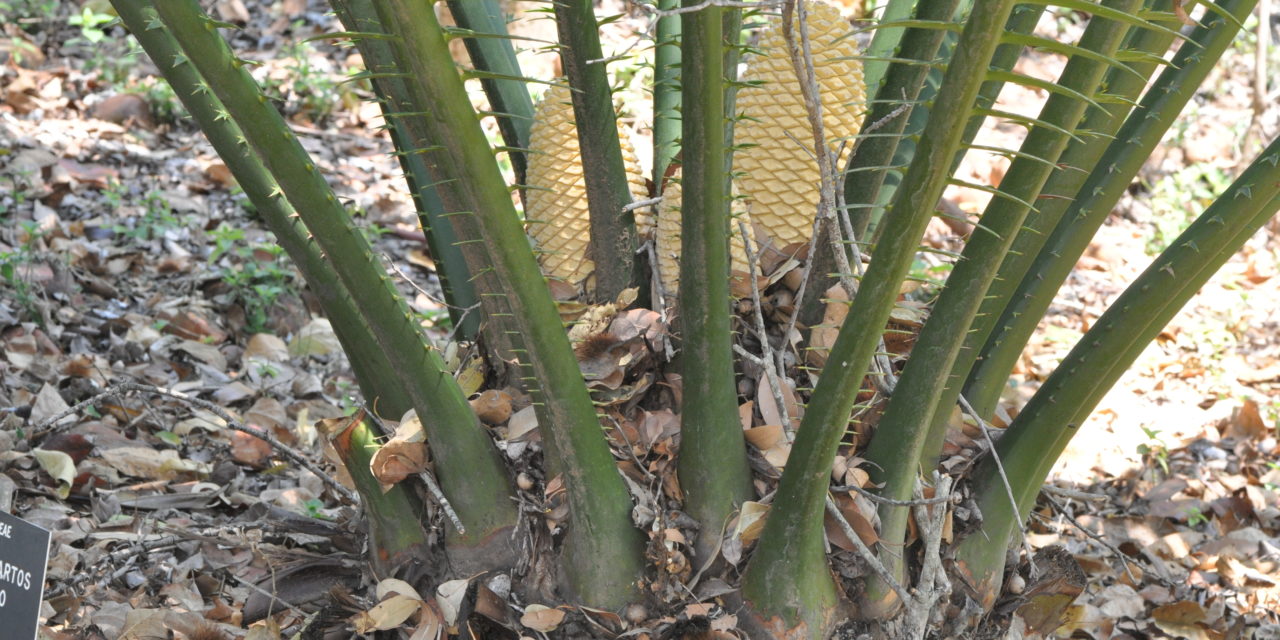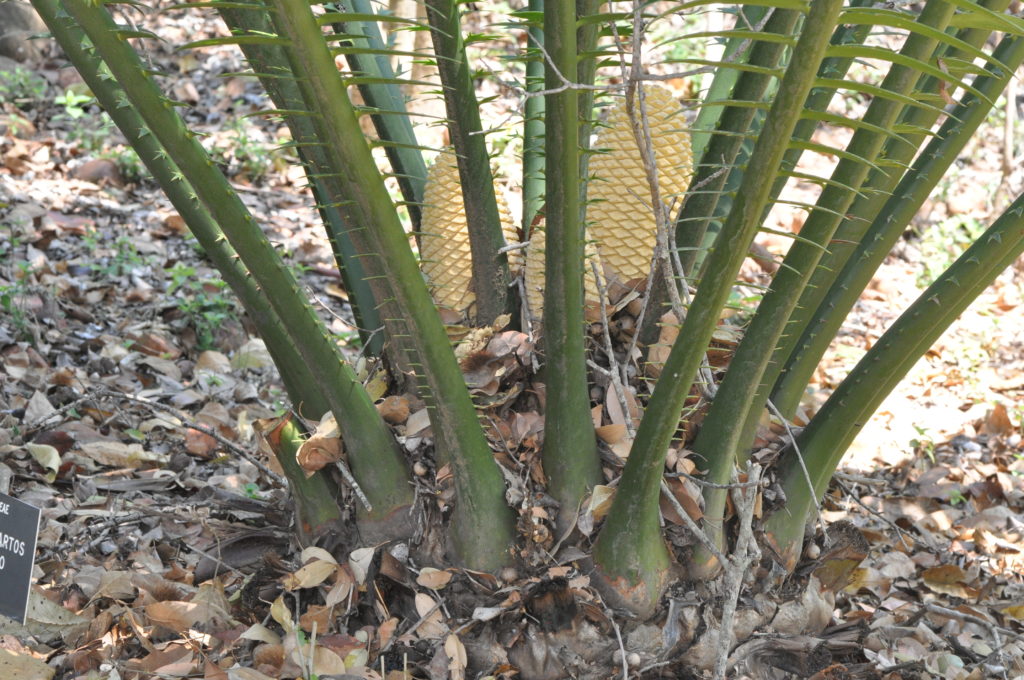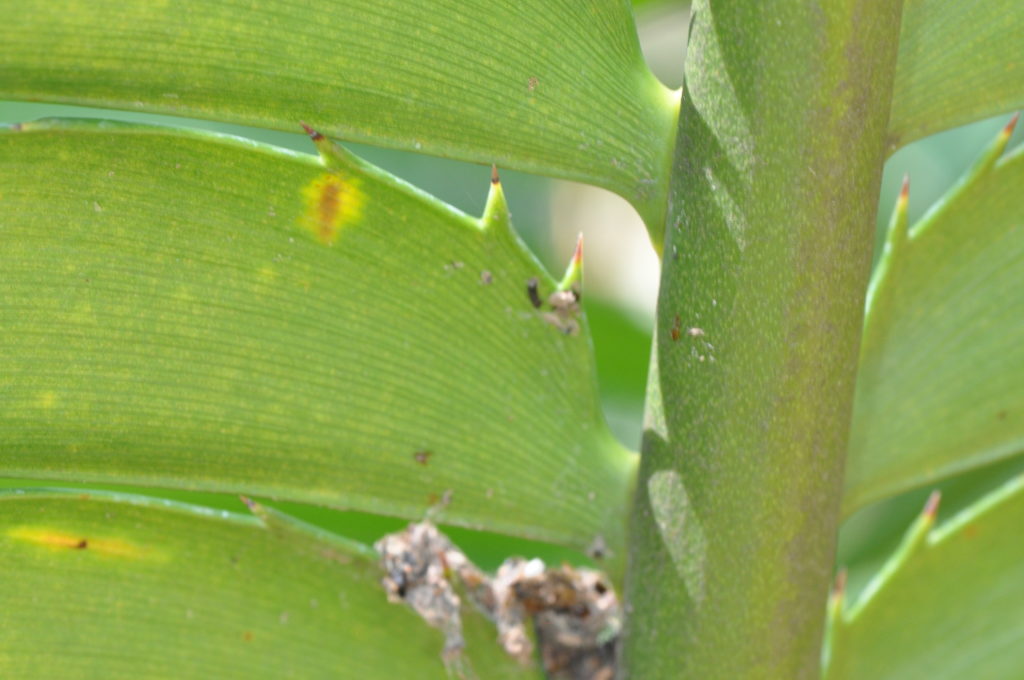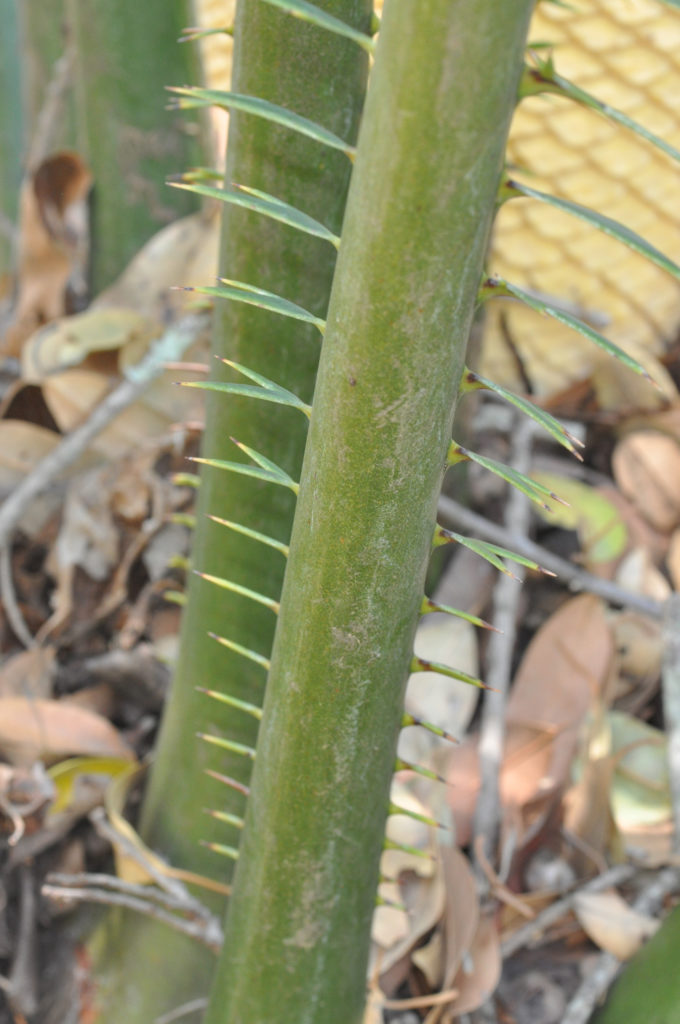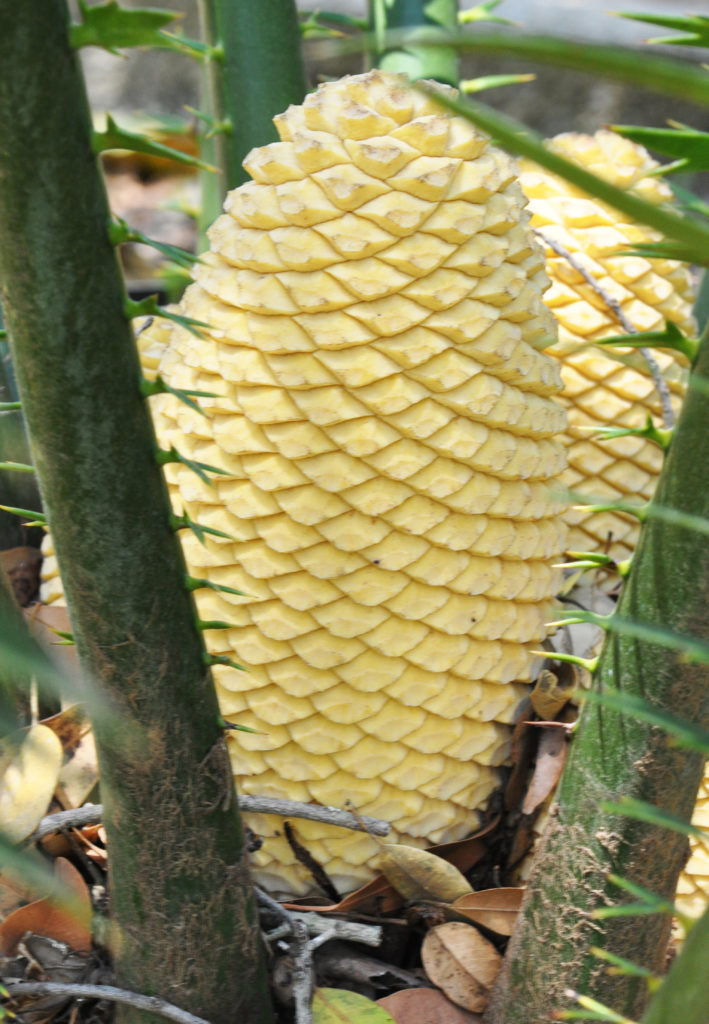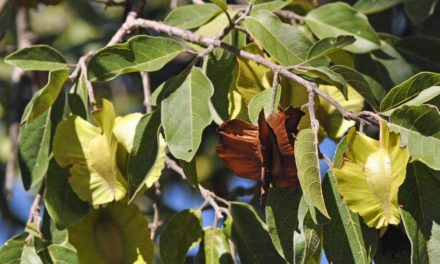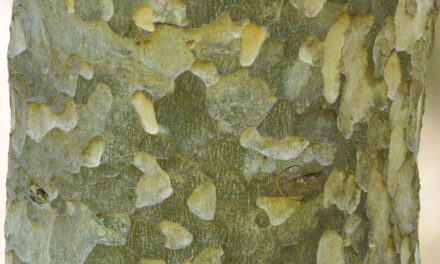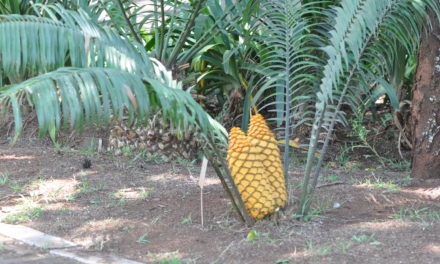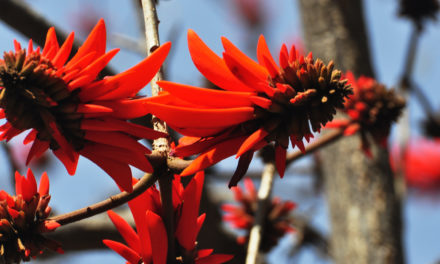General Info – summary
This endangered dioecious and relatively fast-growing Cycad is usually erect but may be decumbent with a trunk reaching 3m in length and 50cm in diameter. The pinnately compound Leaves are up to 3,5m long with base leaflets reduced to spines. Annually produced male Cones are up to 60 x 11cm. Attractive wider yellow female Cones usually only develop every other year. Yellow poisonous Seeds have a fleshy testa.
Description
Encephalartos kisambo
Previous Names: Encephalartos voiensis.
SA Tree No. n/a: Not found in the SA.
Common name: Voi cycad.
Family: Zamiaceae. This family is part of the major group: Gymnosperms. They are cone-bearing plants producing naked seeds and include Ginkgo, Cycads Conifers and Gnetophytes: e.g. Welwitschia mirabilis. Members have no flowers or fruit and the seeds are often contained in Cones. The gymnosperm family Zamiaceae has 9 genera including Encephalartos (cycads).
Name derivation: Encephalartos within-head-bread: referring to the starchy bread that can be made from the pith of the inner trunk. kisambo – from the local Taita people (within Kenya. They speak Kidawida). All cycads fall within the genus Encephalartos, which includes some of the most primitive living Gymnosperms.
Species of Encephalartos (Cycads) are only superficially palm or fern like and are usually unbranched. The cycad tap Root is usually soon replaced by lateral roots, which become woody. Cycads have Coralloid Roots that contain symbiotic cyanobacteria (blue-green algae) that fix atmospheric nitrogen. Through a process of complex biological pathways, the cyanobacteria convert atmospheric molecular nitrogen into compounds such as ammonia, and amino acids needed by the cycads. They are unique Gymnosperms with evergreen, pinnately compound Leaves and only leaf scars eventually remain on the trunk once the leaves fall. Unlike other members of the family Zamiaceae, the cycads have leaflets that lack a central Midrib (vein). The hard leaflets do not bend easily and the sunken veins are parallel. Stomata (structure utilising 2 guard cells that, unlike lenticels, can control gaseous exchange) are present on the lower surface and may occur above. All species are dioecious with male and female Cones developing on separate plants. These cones develop in the centre of the leaf whorls. All species of cycads produce Motile Sperm, which do not move along a pollen tube. At maturity, Seeds are released when the Female cones disintegrate. All seeds produce carcinogenic and neurotoxic glycosides (cycasins). These are poisonous to mammals. The African plants in the genus Encephalartos include about 66 species and 35+ species occur in southern Africa.
Conservation Status. Endangered. 2003. According to the IUCN (The International Union for Conservation of Nature), these trees are only found in 4 locations and may become Critically Endangered in the near future. This cycad is threatened by over collection, habitat loss and removal when other trees are collected for charcoal production.
Tree
This Cycad trunk may reach 3,5m high, but is usually smaller, especially in the open. The erect trunk may be decumbent (reclining or lying on the ground but with the end ascending). The trunk, which tends to taper towards the end, may have a diameter slightly in excess of 0,5m. Several trunks may be present. It also develops a large taproot. The cycad tap Root is usually soon replaced by lateral roots, which become woody. Species of Encephalartos (Cycads) are only superficially palm or fern like and are usually unbranched. Eventually, once the whole leaves fall, only leaf scars remain on the trunk.
Leaves
These evergreen Trees have Leaves up to 3,5m, and are pinnately compound (leaflets arranged along either side of the leaf Rachis – the central stalk, like a feather). Leaves are located around trunk ends. Unlike other members of the family Zamiaceae, the cycads have Leaflets that lack a central Midrib. The leaf Rachis (main axis bearing flowers or leaflets) has a distinctive, swollen non-grooved Petiole (leaf base – photo 845). When the entire leaf falls, a Leaf Scar remains visible on the caudex (stem). Leaves are semi-glossy and have a gradually narrowing Base. The coriaceous (leathery), pungent, and nearly opposite Leaflets are lanceolate and up to 35cm long. ). The leaflets are oblong with a rounded Apex and parallel veins are visible with a hand lens (photo 847). Leaflets are more widely spaced when trees grow in shady areas. Prickles may be present on leaflet margins (photo 847). Leaflet size decrease down the leaf and the leaflets eventually become short spines (photo 848). Stomata (structure utilising 2 guard cells that, unlike lenticels, can control gaseous exchange) are present in the leaflets. Details can be seen with a microscope.
- Photo 845: David Becking.
- Photo 847 : David Becking.
- Photo 848: David Becking.
Cones
Gymnosperms have unenclosed or naked seeds. They have no flowers or fruit and the seeds are often contained in cones. In the Angiosperms (flowering plants), the seeds are enclosed in an Ovary. In the Gymnosperms, there are 2 modes of fertilization. In all the Cycads (including Encephalartos) and the single extant (not extinct) species of Ginkgo biloba, the male cones produce motile sperm, which do not move along a pollen tube, whereas the remaining members of the Gymnosperms all have non-motile sperm with no flagella and are moved along with a pollen tube to the egg. This dioecious tree (produces male and female Cones on separate plants). Up to 6 and almost cylindrical Male Cones are often produced annually. They may reach 60cm in length and up to 12cm in diameter. The impressive yellow Female Cones (photo 846) may reach 60cm long with a diameter of close to 20cm. They take about 12 months to develop and may only appear every other year. The fleshy Testa (seed coat) is yellow, and each Seed is up to 4cm long. At maturity, seeds are released when the Female cones disintegrate.
- Photo 846: David Becking.
Distribution & Ecology
This Cycad is located on hillsides in southern Kenya and northern Tanzania and is found in misty rain forests or in dried mountainsides. These trees often occur in groups or are solitary. Their elevation range is between 800 and 1 800m. In its natural area, it may be home to a number of epiphytic plants, including Orchids. Compared to the cycad norm, this plant is relatively fast growing. Cycads have Coralloid Roots that contain symbiotic cyanobacteria (blue-green algae) that fix atmospheric nitrogen. Through a process of complex biological pathways, the cyanobacteria convert atmospheric molecular nitrogen into compounds such as ammonia and amino acids, needed by the cycads. Unlike most cycads, this plant is content in both light and heavy rainfall areas. However, it is frost sensitive.
Ethnobotany
Plant this cycad in light shade, preferably out of a frost environment. They do survive close to sea level. Suckering is infrequent. All Seeds produce carcinogenic and neurotoxic glycosides (cycasins). These are poisonous to mammals including man. N.B. handle the seeds with gloves. This plant is popular in gardens and does well in a pot. In order to produce seeds, both male and female plants are required.
References
https://en.wikipedia.org/wiki/Encephalartos_kisambo
http://www.iucnredlist.org/details/41906/0
http://www.cycadinternational.com.au/knowlege-centre/2-plants/132-extract-from-qthe-cycadsq-by-loran-m-whitelock79
http://www.cycad.org/documents/TCN-Focus-March-2009-Encephalartos-kisambo.pdf
http://www.wild-about-you.com/CycadKisambo.htm
http://biodiversityadvisor.sanbi.org/wp-content/uploads/sanbi-identify-it/plants/encephalartos.
htmhttp://www.theplantlist.org/browse/G/Zamiaceae/
https://www.diffen.com/difference/Angiosperms_vs_Gymnosperms

